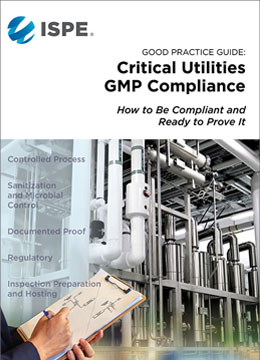Good Practice Guide: Critical Utilities GMP Compliance

Published: June 2020
Pages: 100
Because of their hidden nature, critical utility systems are vulnerable to non-compliance. With their potential to impact product quality or performance in a significant way, critical utilities consistently receive close scrutiny by regulatory inspectors. The goal of the ISPE Good Practice Guide: Critical Utilities GMP Compliance – How to Be Compliant and Ready to Prove It is to help pharmaceutical organizations achieve and maintain their critical utility systems in a state of control, and then be able to efficiently demonstrate their systems’ Good Manufacturing Practice (GMP) compliance to regulatory inspectors and auditors.
ISPE Good Practice Guide: Critical Utilities GMP Compliance Overview
To help meet this goal, this Good Practice Guide provides best practices with respect to GMP compliance of critical utility systems. This Guide covers water systems, pure steam, compressed air, and medical gases, as well as processes unique to critical utilities, such as maintaining piping layout drawings and avoiding poor sampling techniques at points of use. Specific critical utility inspection and audit preparation activities are presented, as are broadly applicable best practices, resulting in a comprehensive Good Practice Guide useful in pharmaceutical manufacturing facilities.
ISPE Good Practice Guide: Critical Utilities GMP Compliance – How to Be Compliant and Ready to Prove It serves as a companion document to other ISPE Guides, for example, ISPE Baseline® Pharmaceutical Engineering Guide, Volume 4 – Water and Steam Systems.
Emerging Economy Publication Discount
ISPE members located in nations with emerging economies* are eligible for a 50% discount on publications from the regular member price. To receive the discount, members must be logged in with their ISPE member account. Contact Member Services at ask@ispe.org for more information or if you have questions about your membership status or this discount program. Discounts do not apply to Accuris (formerly Techstreet) document downloads.
*Based on the World Bank's system for classifying national economies by GNI per capita. Includes low-income, lower middle-income, and upper middle-income economies. To learn more about the World Bank classification system, please click here. Currently includes the following nations, except where international sanctions apply:
- Afghanistan
- Albania
- Algeria
- Angola
- Argentina
- Armenia
- Azerbaijan
- Bangladesh
- Belarus
- Belize
- Benin
- Bhutan
- Bolivia
- Bosnia and Herzegovina
- Botswana
- Brazil
- Bulgaria
- Burkina Faso
- Burundi
- Cabo Verde
- Cambodia
- Cameroon
- Central African Republic
- Chad
- China
- Colombia
- Comoros
- Congo, Dem. Rep.
- Congo, Rep.
- Costa Rica
- Côte d’Ivoire
- Cuba
- Djibouti
- Dominica
- Dominican Republic
- Ecuador
- Egypt, Arab Rep.
- El Salvador
- Equatorial Guinea
- Eritrea
- Eswatini
- Ethiopia
- Fiji
- Gabon
- Gambia, The
- Georgia
- Ghana
- Grenada
- Guatemala
- Guinea
- Guinea-Bissau
- Haiti
- Honduras
- India
- Indonesia
- Iran, Islamic Rep.
- Iraq
- Jamaica
- Jordan
- Kazakhstan
- Kenya
- Kiribati
- Korea, Dem. People's Rep.
- Kosovo
- Kyrgyz Republic
- Lao PDR
- Lebanon
- Lesotho
- Liberia
- Libya
- Madagascar
- Malawi
- Malaysia
- Maldives
- Mali
- Marshall Islands
- Mauritania
- Mauritius
- Mexico
- Micronesia, Fed. Sts.
- Moldova
- Mongolia
- Montenegro
- Morocco
- Mozambique
- Myanmar
- Namibia
- Nepal
- Nicaragua
- Niger
- Nigeria
- North Macedonia
- Pakistan
- Palau
- Papua New Guinea
- Paraguay
- Peru
- Philippines
- Russian Federation
- Rwanda
- Samoa
- São Tomé and Príncipe
- Senegal
- Serbia
- Sierra Leone
- Solomon Islands
- Somalia
- South Africa
- South Sudan
- Sri Lanka
- St. Lucia
- St. Vincent and the Grenadines
- Sudan
- Suriname
- Syrian Arab Republic
- Tajikistan
- Tanzania
- Thailand
- Timor-Leste
- Togo
- Tonga
- Tunisia
- Türkiye
- Turkmenistan
- Tuvalu
- Uganda
- Ukraine
- Uzbekistan
- Vanuatu
- Vietnam
- West Bank and Gaza
- Yemen, Rep.
- Zambia
- Zimbabwe